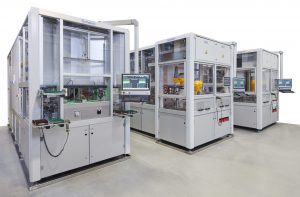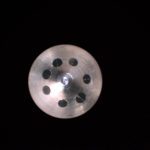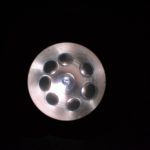
In hydroerosive machining, an abrasive fluid loaded with abrasive particles is pumped under high pressure through the interior geometry of a workpiece. In this way, components can be deburred, rounded or the user is able to calibrate the flow rate of a given bore. This procedure is applied in various industries, ranging from the automotive sector to the watchmaking trade.
The decisive factor for the workpieces is the size of the bore that needs to be worked. The machines can grind bores with diameters from 0.1 to 5mm. The workpieces can be made of stainless steel, aluminum, gold, glass or plastic. The characteristics of the grinding medium are then specially adapted to the requirements of the workpiece that is to be machined in order to achieve the desired flow rates, geometries and degrees of rounding. Highly abrasive ceramics, aluminum oxide or even artificial diamond can be used as abrasive grit.
- The sample shows an nickel component before hydroerosive machining.
- And after hydroerosive machining.
In addition to rounding and deburring, the hydroerosive process can also be used for accurate flow calibration of bores. A fluid with low viscosity is selected for this purpose. The operator can monitor the increasing flow rate online during the entire process, adjust the required value and thus set the flow rate tolerances in a process-safe manner.
Sonplas GmbH also equips the systems with rotary tables so that processes such as grinding, rinsing and measuring the flow rate can run in parallel. Depending on requirements, each component can thus pass through up to eight stations. The user can adapt his special machine modularly to his requirements and also have databases and MES systems connected. The equipment is a closed system in which the human operator at the machine only has to take care of manual loading.
Click here for the full article!

